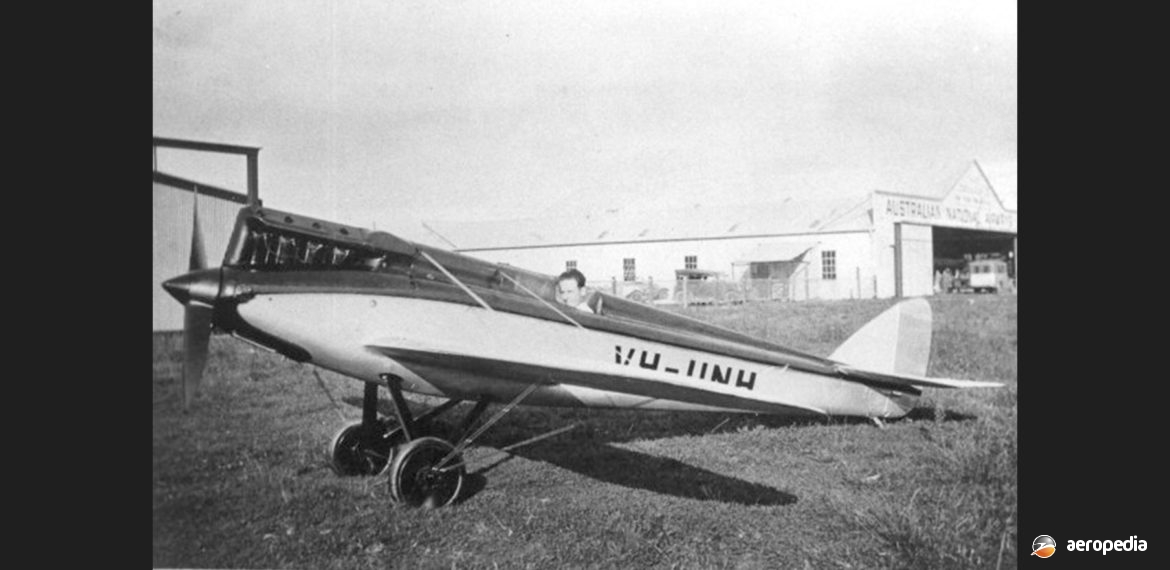Photograph:
de Havilland DH.71 VH-UNH Tiger Moth (c/n 323) at Mascot, NSW in 1930 (Author’s collection)
Country of origin:
United Kingdom
Description:
Single-seat light sport and racing aircraft
Power Plant:
One 101 kw (135 hp) de Havilland Gipsy I four-cylinder in-line air-cooled engine
Specifications:
- Wingspan (normal): 6.86 m (22 ft 6 in)
- Wingspan (special): 5.79 m (19 ft)
- Length: 5.69 m (18 ft 7 in)
- Height: 2.13 m (7 ft)
- Wing area (normal): 7.12 m² (76.5 sq ft)
- Wing area (special): 5.80 m² (62.5 sq ft)
- Max speed (normal): 267 km/h (166 mph)
- Max speed (special): 311 km/h (193 mph)
- Landing speed (normal): 97 km/ h (60 mph)
- Fuel capacity: 76 litres (16.75 Imp gals)
- Empty weight (normal): 280 kg (618 lb)
- Disposable load: 130 kg (287 lb)
- Loaded weight: 410 kg (905 lb)
- Wing loading: 57.8 kg/m² (11.83 lb/sq ft)
- Power loading: 3.17 kg/hp (6.96 lb/hp)
History:
The de Havilland DH.71 Tiger Moth was built in secrecy at Stag Lane in Edgeware, Middlesex in 1927 for high-speed research, mainly to act as a flying test-bed for a new series of engines being designed by Major F B Halford. Designed as small as possible to achieve high-performance, the cockpit was tailored to fit the Company’s chief test pilot, Hubert Broad. Only two examples were built, but they had fascinating lives, creating a lot of interest over the recent years, with replicas being built on both sides of the Atlantic Ocean.
The wings were of normal construction, with I-section spruce spars and wooden ribs. Each wing was built in two halves, the spars forming a butt joint on the centre-line, being secured with steel places and bolts. Wing bracing was by streamline wires in duplicate. The ailerons were operated by torque tubes and cranks. The undercarriage had the shock-absorbing contained in the wheels, there being no axle. The centre discs of the wheels attached to the apices of the undercarriage VEEs, and streamline wires ran across from one wheel centre to the other. The fuselage was of plywood-covered structure following normal de Havilland practice of the time.
Both aircraft were entered for the Kings Cup Race to be held at Hucknall in Nottinghamshire on 30 July 1927, the pilots being Hubert Broad and C D Barnard. The first DH.71 G-EBQU (c/n 323) was initially fitted with a 63 kw (85 hp) Cirrus II engine and made its first flight at Stag Lane on 24 June 1927. It was then re-engined with the prototype of the Gipsy I engine and withdrawn from the race in order to be used for record breaking. The second DH.71 aircraft G-EBRV (c/n 324) was also fitted with a Cirrus II engine.
Both aircraft were found to be extremely unstable in the air. Wingspan was originally 6.85 m (22 ft 6 in) but, in order for an attempt to be made on the Light Aeroplane Category Class III 100 km (62 miles) speed course, it was reduced to 5.79 m (19 ft). An attempt was made on 24 August 1927 and a speed of 300.08 km/h (186.47 mph) was achieved. On 29 August an attempt was made on the World Altitude Record in the same category and Broad achieved 5,849.4 m (19,191 ft) in 17 minutes but had to stop the attempt due to lack of oxygen equipment, the aircraft at the time still climbing at more than 305 m/min (1,000 ft/min).
In 1930 the prototype (c/n 323) was shipped to Australia for Frank K Bardsley of Penshurst, NSW. It became VH-UNH and was test-flown at Point Cook, VIC by Major Hereward de Havilland. It was later flown from Mascot to Richmond in NSW. However, on 17 September 1930, whilst being flown by Mr David Smith, the aircraft became unstable in the air during a test flight and Smith, who was thought not to be wearing a seatbelt, was thrown from the aircraft and killed, the aircraft being destroyed when it crashed into a nursery at Mascot.
The second aircraft G-EBRV was never fitted with a Gipsy engine and never flew after the 1927 King’s Cup Race. It was only placed on static display a few times and then stored in the roof of de Havilland’s Hatfield hangar in Hertfordshire where it was destroyed by a direct hit from a Luftwaffe Junkers Ju-88 in 1942.
A number of replicas have been or are being built. One (G-ECDX) was built in Hampshire, UK; another (N371DH) in New York, USA; and another (painted as G-EBQU) in Sheffield, UK.

